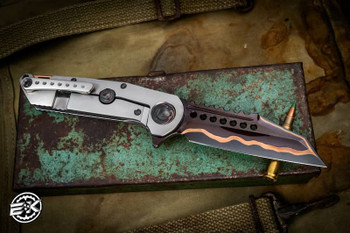A Cut Above: Why Expensive Knives Cost More
Posted by EKnives on Jun 4th 2024
When you’re shopping for knives, you probably notice the price range can vary quite a bit. What is the difference between the $20 EDC knife you can pick up at your local big-box store and the more expensive options at an online knife store? If they both come with a sharp blade, does it really matter?
Yes, it turns out it really does.
Why the Price Tag?
Let’s break down what makes some knives more expensive than others.
Quality Manufacturing
How manufacturers assemble knives is a large factor in determining their price point. Inexpensive knives are cut or stamped out in a knife shape from a sheet of metal. Manufacturers making more expensive knives forge the metal. Forged blades are formed by melting the metal down, which strengthens it as it solidifies into the shape of the blade. These reinforced blades are also easier to sharpen than stamped knives.
If you’re curious whether your blade was stamped or forged, look where the blade and handle meet. If the knife has a bolster (wide lip between the blade and the handle) and tang (the metal from the blade that goes into the handle), it is forged.
Quality Materials
Steel is one of the most common blade materials for knives on the market, but not all steel is the same. Here is a breakdown of the four different types of steel:
- Stainless steel: This steel variation is the shiniest option, with 10.5-30% chromium in its composition. This also makes it resistant to corrosion.
- Carbon steel: Carbon steel has a higher carbon content than other steels, but still no more than 2%. Carbon steel can come in low, medium, and high, with high carbon steel blades being the best quality.
- Tool steel: Named for the versatility it has to make different tools, tool steel can come in different varieties such as oil-hardening, shock-resistant, or water-hardening.
- Alloy steel: Different types of alloys (aluminum, silicon, magnesium, copper, etc.) make up alloy steel. Manufacturers can use this type of steel for a wide variety of knives since it has so many versatile properties.
The manufacturer can make the handles from various materials as well, with differing levels of quality that can raise the overall price of a knife.
Aesthetics
Let’s be honest; no one wants an ugly knife. For many knife collectors, the better-looking or the more unique the knife, the better. The blade and handle can both have an aesthetic appeal that can add to the final cost of a product.
For example, the Marifone Custom Warhound Folder Titanium Copper CF Inlay has a ribbon of copper in both the blade and the handle. This striking design increases the aesthetics and the price. The Benchmade Meatcrafter Fixed Blade Hunting Knife is another example of aesthetic appeal. When you’re shopping for Benchmade fixed blade knives, the appearance will not disappoint.
Overhead Costs
Manufacturing and selling knives isn’t a cheap hobby. The equipment, materials, cost of labor, storage space, and shipping material costs all add up.
Accessories
Knives can come with additional accessories that might increase the price point. For example, the Marifone Custom UTX-70 Brass/CF Inlay OTF Automatic knife comes with a magnetic carbon fiber box, a soft cloth, and a padded zippered pouch.
Warranties
Some knives have an option to add a warranty, which is another additional cost. Warranties help protect the buyer when they are spending a lot of money to make sure the product they receive is satisfactory. They prove that the manufacturer stands by its product.
Quality Control
Not every knife forged meets the manufacturer's standards; therefore, they can’t sell it to the public. Quality control helps make sure the product is satisfactory, but adequate quality control can be extensive and expensive. Following quality control processes helps the manufacturer rest assured that they are providing the best product they can.
Limited Editions
Like other collectibles, knife manufacturers occasionally release limited editions. This increases their value as the manufacturer will not continually produce this style according to demand. You can resell collectible knives for high price points, especially to people trying to complete a set.
You Get What You Pay For
Like many things in life, you’ll get what you pay for. The $20 EDC knife you found at a big-box store will work for a time. But you can’t match the quality, longevity, and aesthetics that come with investing in a higher-quality product.

